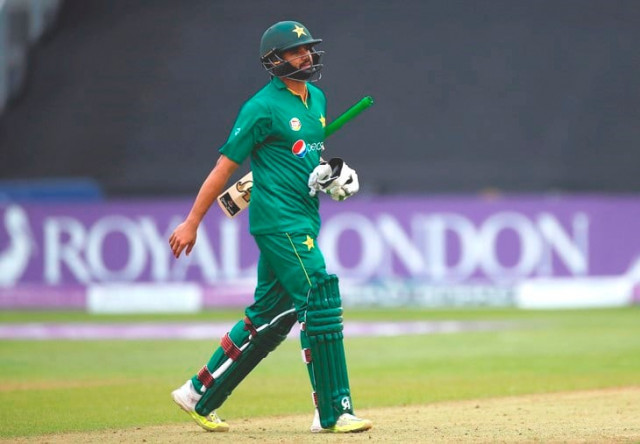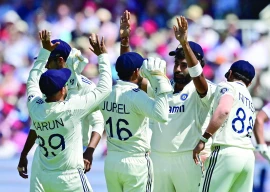
Even though each and every victory is important and should give us hope, but hope for the sake of hope isn’t the answer to the questions that have been there for a while and are gaining traction with each passing ODI.
ODI Rankings: Pakistan plummet to lowest points tally since 2001
After the 2011 World Cup, Pakistan ODI cricket remained in a fragile state; the state that resembles a foggy morning of winter, where you are going on a road without much knowledge of what’s in front of you.
Knowing that there were numerous reasons for the team’s decline in their performances in the shorter format, one problem that remains constant is ‘confusion’ or ‘lack of clarity’, which started during the era of Misbahul Haq and continues to haunt the team even after all those years.
Azhar: The wrong choice as a captain or as a player?
 PHOTO: REUTERS
PHOTO: REUTERSIn the recently concluded series, it was all on show once again. For instance, Azhar Ali, who is now leading the team in the 50-over format for more than a year, remains a question not many can answer.
He started the series with seven wins and 11 losses, finishing with eight wins and 15 losses – a record which is worst amongst captains the country has ever had.
Azhar Mahmood wants Pakistan to learn their English lessons
The 31-year-old scored 208 runs in five innings, which included two scores of 80+, but both times he faced more than 100 balls, and spent in excess of 30 overs at the crease with a strike rate of just over 75.
One can tell that he is trying his ultimate best to deliver, but unfortunately for him, he is living in the era of the likes of Alex Hales, who scored 171 in a mere 37 overs when he was batting in the third ODI. So the question remains — can we afford to give him more time as a captain who just can’t produce results? And if not, can we afford him in the playing eleven with the lowest strike-rate? We know the answer as much as you do.
Babar Azam and Sharjeel Khan: Youngsters or failures?
 PHOTO: REUTERS
PHOTO: REUTERSNow about potential youngsters, i.e Sharjeel Khan and Babar Azam. Both were given a fair run by the team management, but both finished with averages of 20 and 24 runs respectively after five innings each.
It may not have looked as bad had they been touring England for the first time with any team, but thanks to the Pakistan Cricket Board (PCB), they had sufficient practice before the start of the series with the nation’s A team, that had spent plenty of time playing in English conditions.
Pakistan claim consolation win with little on the line
What’s more demoralising for the fans and the viewers is that these highly rated youngsters, who are supposed to take the Pakistan team forward, keep giving away good starts, which must be a real cause of concern for the team management and the selection committee, who are banking on them to serve the Men in Green in the future.
Who is Shoaib Malik?
 PHOTO: REUTERS
PHOTO: REUTERSNow let’s discuss Shoaib Malik, a mystery in Pakistan cricket that is yet to be solved even after him playing 15 years of international cricket for the country.
The 34-year-old started his career primarily as an off-spinner, but it became clear that he can also bat a bit. The team management then turned him into a bowling all-rounder, but after a while, they realised he was more of a batting all-rounder, and later realised that he is just primarily a batsman who can now bowl a bit.
He started his career batting at number ten, then promoted to number seven, then gradually to six, three and opening spot. Then followed a rollercoaster ride when he moved to number four, seven, three, five, six and in the last match back to number four. Can anyone guess what’s going on there? At least we can’t.
It is quite interesting to notice that cricket concerned circles in this country are still unsure of what kind of role the 34-year-old has in this team.
Malik’s most recent return to the ODI team took place in 2015, and since then averages more than 58 in 21 innings, which is a fair enough record. However, 16 of those innings came between number three and number five in the batting order, where he averages nearly 62, but suddenly our new team management realised ‘Oh! He is our best finisher’, and guess what? He failed once again.
His demotion in the batting order was even more mind baffling after looking at his stats throughout the career, where his best batting positions are three, four or five, where he averaged 41.69, 44.40 and 35.17.
By doing that, the team management made Mohammad Rizwan sit out for most of the series, who is probably the best fielder we have in the squad.
One can expect that after 15 years of international cricket, the cricket board, selection committee and team management should know that it is absolutely a no-brainer that Malik cannot make it to the playing eleven if he is batting below number five in the batting order. But to begin with, can you tell us why he was demoted? No one really knows.
 PHOTO: REUTERS
PHOTO: REUTERSNo rise is unplanned, and there is no plan without knowing the clear path. That was the key to the evolution of Sarfraz Ahmed and Imad Wasim throughout the ODI series, where they knew when they were going, and they also knew what the team was demanding from them.
We can’t produce David Warners, Joe Roots and Virat Kohli overnight, but can we become the New Zealand of mid 2000s, where a bunch of honest players without world-class talent survived in the mix? Only time will tell.
They had Stephen Fleming as their leader, who knows what he was doing and why was he in the team, and they kept their plan simple. Perhaps it’s time we should take some leaves out of their book, which makes sure that this transition, which will be painful, might be shorter than many expect it to be.


















COMMENTS
Comments are moderated and generally will be posted if they are on-topic and not abusive.
For more information, please see our Comments FAQ